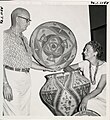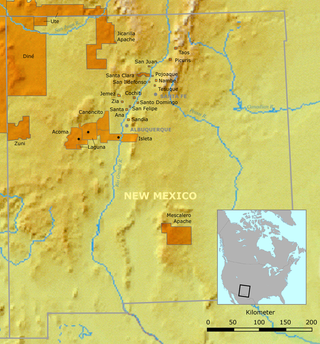
The Puebloans, or Pueblo peoples, are Native Americans in the Southwestern United States who share common agricultural, material, and religious practices. Among the currently inhabited Pueblos, Taos, San Ildefonso, Acoma, Zuni, and Hopi are some of the most commonly known. Pueblo people speak languages from four different language families, and each Pueblo is further divided culturally by kinship systems and agricultural practices, although all cultivate varieties of corn (maize).

Pueblo refers to the settlements and to the Native American tribes of the Pueblo peoples in the Southwestern United States, currently in New Mexico, Arizona, and Texas. The permanent communities, including some of the oldest continually occupied settlements in the United States, are called pueblos (lowercased).
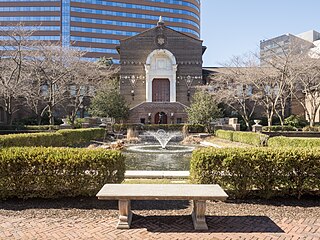
The Penn Museum is an archaeology and anthropology museum at the University of Pennsylvania. It is located on Penn's campus in the University City neighborhood of Philadelphia, at the intersection of 33rd and South Streets. Housing over 1.3 million artifacts, the museum features one of the most comprehensive collections of Middle and Near-Eastern art in the world.

Hovenweep National Monument is located on land in southwestern Colorado and southeastern Utah, between Cortez, Colorado and Blanding, Utah on the Cajon Mesa of the Great Sage Plain. Shallow tributaries run through the wide and deep canyons into the San Juan River.

The Manitou Cliff Dwellings are a privately owned tourist attraction consisting of replica Ancestral Puebloan cliff dwellings and interpretive exhibits located just west of Colorado Springs, Colorado, on U.S. Highway 24 in Manitou Springs.
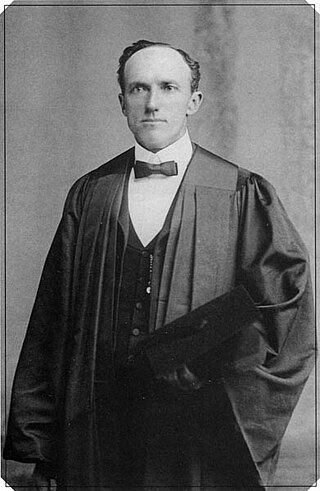
Edgar Lee Hewett was an American archaeologist and anthropologist whose focus was the Native American communities of New Mexico and the southwestern United States. He is best known for his role in gaining passage of the Antiquities Act, a pioneering piece of legislation for the conservation movement; as the founder and first director of the Museum of New Mexico; and as the first president of the New Mexico Normal School, now New Mexico Highlands University.

Salmon Ruins is an ancient Chacoan and Pueblo site located in the northwest corner of New Mexico, USA. Salmon was constructed by migrants from Chaco Canyon around 1090 CE, with 275 to 300 original rooms spread across three stories, an elevated tower kiva in its central portion, and a great kiva in its plaza. Subsequent use by local Middle San Juan people resulted in extensive modifications to the original building, with the reuse of hundreds of rooms, division of many of the original large, Chacoan rooms into smaller rooms, and emplacement of more than 20 small kivas into pueblo rooms and plaza areas. The site was occupied by ancient Ancestral Puebloans until the 1280s, when much of the site was destroyed by fire and abandoned. The pueblo is situated on the north bank of the San Juan River, just to the west of the modern town of Bloomfield, New Mexico, and about 45 miles (72 km) north of Pueblo Bonito in Chaco Canyon. The site was built on the first alluvial terrace above the San Juan River floodplain.

Pottery Mound was a late prehistoric village on the bank of the Rio Puerco, west of Los Lunas, New Mexico. It was an adobe pueblo most likely occupied between 1350 and 1500. The site is best known for its 17 kivas, which yielded a large number of murals. A 2007 book, New Perspectives on Pottery Mound Pueblo provides a general introduction to the site.
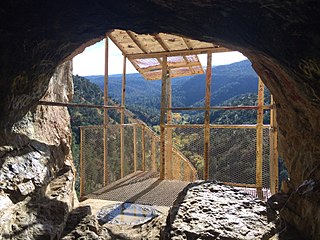
Sandia Cave, also called the Sandia Man Cave, is an archaeological site near Bernalillo, New Mexico, within Cibola National Forest. First discovered and excavated in the 1930s, the site exhibits purported evidence of human use from 9,000 to 11,000 years ago. It was declared a National Historic Landmark in 1961. The site is open to the public, up a difficult half-mile trail off New Mexico State Road 165.

Frank Cumming Hibben was a well-known archaeologist whose research focused on the U.S. Southwest. As a professor at the University of New Mexico (UNM) and writer of popular books and articles, he inspired many people to study archaeology. He was also controversial, being suspected of scientific fraud during his studies of Paleo-Indian cultures.
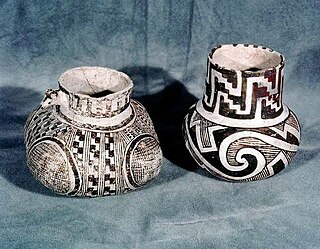
Cibola White Ware is a ceramic tradition of Arizona and New Mexico, dating from 1225–1325 CE.

The University of New Mexico Art Museum is an art museum at the University of New Mexico in Albuquerque. The museum's permanent collection includes nearly 30,000 objects, making it the largest collection of fine art in New Mexico.
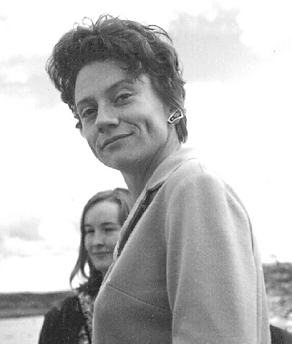
Cynthia Irwin-Williams was an archaeologist of the prehistoric American Southwest. She received a B.A. in Anthropology from Radcliffe College in 1957; the next year she received a M.A. in the same field. In 1963 she completed her educational career in Anthropology with a PhD. from Harvard University. Beginning her career in the 1950s, Irwin-Williams was considered a groundbreaker for women in archaeology, like her friend and supporter Hannah Marie Wormington.

The Ancestral Puebloans, also known as the Anasazi and by the earlier term the Basketmaker-Pueblo culture, were an ancient Native American culture that spanned the present-day Four Corners region of the United States, comprising southeastern Utah, northeastern Arizona, northwestern New Mexico, and southwestern Colorado. They are believed to have developed, at least in part, from the Oshara tradition, which developed from the Picosa culture. The people and their archaeological culture are often referred to as Anasazi, a term introduced by Alfred V. Kidder from the Navajo word anaasází meaning 'enemy ancestors' although Kidder thought it meant 'old people'. Contemporary Puebloans object to the use of this term, with some viewing it as derogatory.

Rick Dillingham (1952–1994) was an American ceramic artist, scholar, collector and museum professional best known for his broken pot technique and scholarly publications on Pueblo pottery.
Marta Weigle was an American anthropologist and folklorist.
Laurencita R. Herrera (1912–1984) was a renowned Native American Cochiti Pueblo artist, specializing in traditional Cochiti figurative pottery called storytellers and her pottery vessels. She is of the Herrera family, a renowned family of Pueblo potters in New Mexico, whose work is often found in art collections and art museums. She was an actively making pottery between the 1930s through the 1970s and is known as one of the, "finest Cochiti potters of that era".
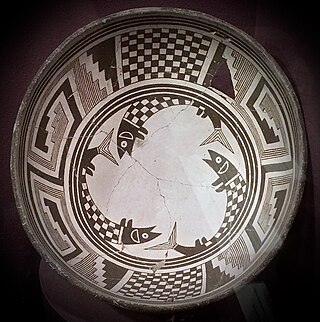
Pueblo pottery are ceramic objects made by the Indigenous Pueblo people and their antecedents, the Ancestral Puebloans and Mogollon cultures in the Southwestern United States and Northern Mexico. For centuries, pottery has been central to pueblo life as a feature of ceremonial and utilitarian usage. The clay is locally sourced, most frequently handmade, and fired traditionally in an earthen pit. These items take the form of storage jars, canteens, serving bowls, seed jars, and ladles. Some utility wares were undecorated except from simple corrugations or marks made with a stick or fingernail, however many examples for centuries were painted with abstract or representational motifs. Some pueblos made effigy vessels, fetishes or figurines. During modern times, pueblo pottery was produced specifically as an art form to serve an economic function. This role is not dissimilar to prehistoric times when pottery was traded throughout the Southwest, and in historic times after contact with the Spanish colonialists.


